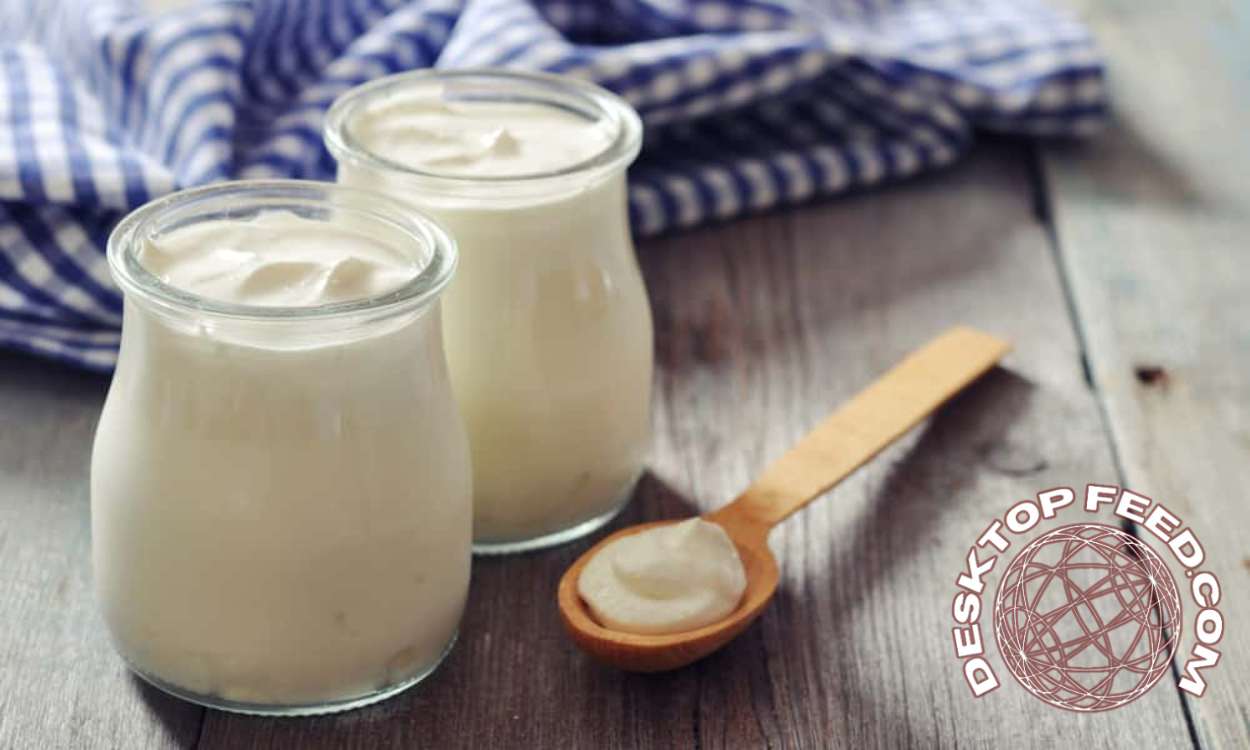Is Yogurt a Solid Or Liquid? Everything You Need

So is yogurt a solid or a liquid? Depending on your location, the answer can be either or both. The milk itself is a mixture of casein proteins and whey fame, and both dairy products contain acids and thickeners. However, commercial yogurt also contains thickeners and gelling agents. Let’s look at the two main types of yogurt. How do they differ from one another? Depending on the region, yogurt is a solid, while kefir is a liquid.
Liquid or Solid? You might think this is a simple question that anyone could answer. In some cases, yes, but in other cases, uh, no. An example of an easy question would be “Is water a liquid or a solid?” your answer would be liquid. Some things are quite easy to classify as liquid or solid. Other things seem to fall into both categories. Like yogurt!
Is Yogurt a Solid Or Liquid?
Yogurt is something that cannot be exactly classified as liquid or solid. It can be a liquid, because it ends up occupying the space you put it in (like water). But it can also be a solid, because it is quite firm (like a brick).
Personally, I think yogurt would be more of a liquid than a solid. If you pour yogurt into a bowl, it wouldn’t just sit there, it would slowly spread out and spread throughout the space of the bowl. If it stays there, then it would be solid, but if it takes up space, then it’s a liquid.
If you searched for “Is yogurt a liquid or a solid”, the results would be many, and many people say it’s neither. I don’t think scientists have bothered to go through experiments and research to answer the question.
Depending on where you live, yogurt is a solid or a liquid
While yogurt is a food that is often considered a liquid, its physical properties are different than those of a liquid. Solids can be molded into various shapes and hold those shapes for a long time. A liquid, however, changes shape as it passes through its container and only maintains its shape while it is contained. Liquids are classified as either liquids or solids depending on their density. The density of a liquid determines how quickly it flows and how much the particles cling together. While some liquids are viscous, others barely flow at all. Yogurt is low enough viscosity to flow and are considered a liquid by the Transportation Security Administration (TSA).
The liquid part of yogurt contains whey, which is a naturally occurring protein found in milk. As the yogurt ages, the whey separates from the curds, forming a cloudy and runny liquid that is high in protein and good for your health. Depending on where you live, yogurt may be solid or liquid. You can choose to consume yogurt either way. If you are unsure of whether or not yogurt is a solid or a liquid, read on to discover how it’s made.
When frozen, yogurt retains its protein and is healthier than traditional yogurt. It is also slower to digest, making you feel full longer. It’s also less dense than traditional yogurt. The frozen variety of yogurt is similar to the original but has undergone a solidification process. The freezing process causes liquids to take on a solid form, which will return to their liquid state when they are returned to their original state.
Kefir is a solid or a liquid
One question that often gets asked is: is kefir a liquid or a solid? The answer depends on the fermentation process. While it can be either, kefir is typically thick and tart. The consistency of kefir can also vary from batch to batch, and even from season to season. Occasionally, kefir will form chunks, which is completely natural. You can discard these lumps if you prefer a more liquid form.
In preparing kefir, the grains resemble tiny cauliflower florets. They are comprised of bacteria, yeast, and casein. The grains can be very small, the size of a wheat grain, or as large as a hazelnut. They are easily identifiable due to their translucent nature and rubbery consistency. During the fermentation process, the kefir grains enlarge and split.
A solid form of kefir has a similar consistency to buttermilk, but can be more or less liquid depending on the temperature. It thickens when refrigerated in winter and when milk has higher fat content. If stored on the counter, it can be thinner. Occasionally, a thin layer can develop as it ferments. If this is the case, you can simply add more milk or a little more sugar until it is the right consistency.
Once it has completed fermentation, kefir is a solid, but if it’s too thin, strain it. Then you can refrigerate it for several hours, or store it at room temperature to keep the flavour fresh. Just remember to check the temperature before eating it! If you have trouble identifying the kefir grains, try placing a wooden spoon in the glass and gently stir. The bumpy texture is the kefir grains.
Milk is made of casein proteins and whey fame
Casein and whey are the two main protein components of milk. Casein is a complete protein, with all nine essential amino acids. Casein is a white solid that contains no taste and is produced by all mammals. Casein is also found in infant formula and cheese. When the milk is processed, its natural emulsion breaks down into curds and whey. The curds consist of milk fat surrounded by a sticky sheath. While casein is the chief protein in milk, whey makes up the other half of the dairy product.
Casein protein is a high-quality protein sourced from milk. Whey is more expensive than casein. However, casein is lower in lactose and is absorbed more slowly than whey. Some research has found that casein is more filling than whey, but it is not conclusive. The protein from casein is often more expensive than whey. Casein is used to make cheese and is a byproduct of the cheese-making process.
Casein is the primary component in cheese. While whey is used in protein supplements, it is also used in animal milk. Casein products are often consumed by bodybuilders after a workout or before bed. Infant formulas also contain casein as a substitute for breast milk. Like casein, it is present in a molecule suspended in a liquid called a micelle.
The b-lactoglobulin is a small protein chain that is not fully digested by the digestive system. If a person is sensitive to peptides, their body may react to them. Typically, the body will react with an inflammatory response to prevent pathogens from invading the body. This reaction may cause severe health problems. But, as with any food supplement, the most important ingredient in whey protein is milk.
Also Read: How To Start A Food Services Business: Things You Need To Know
Commercial yogurt has thickeners and gelling agents
The thickeners and gelling agents in commercial yogurt are based on cellulose or polysaccharides. These ingredients are often polysaccharides such as wheat flour, guar gum, and locust bean gum. They are also cellulose derivatives. A gelling agent can be a polysaccharide or starch that makes a milk product thick and spongy.
Gelling agents are substances that stabilize foods, such as desserts and candies. They help produce a stable, thick consistency by forming a gel. They include natural gums, starches, and pectins. They also include agar-agar and gelatin. Many food ingredients are used as gelling agents, although their properties are not always clear. Nevertheless, they are extremely convenient and effective.
The use of thickeners and gelling agents in commercial yogurt varies. The most important type is hydrocolloids. All hydrocolloids can thicken aqueous dispersions, but only a few form gels. Their character and texture varies widely, and understanding the conditions for gelling is important for designing effective food formulations. Alginate, pectin, and carrageenan are all examples of important gums used as gelling agents. Some of these ingredients also serve as fat substitutes.
Besides the thickeners and gelling agents, commercial yogurt also contains other additives. A thickener makes yogurt more viscous, and a gelling agent prevents it from losing its structure or texture. They also keep the solids in the yogurt in a semi-solid state. Even though they may have a high content of milk proteins, the liquid component of yogurt still floats to the top of the container.
Gellan gum is a highly popular gelling agent, and it has excellent properties. It is a plant-based alternative to gelatin, which is derived from animal tissues. It imparts a smooth, creamy texture to desserts and reduces the risk of certain delicacies melting under heat. These ingredients have an array of benefits, and they all work together to create delicious yogurt. They have various functions, but they all have the same end result – the consistency and taste of commercial yogurt.
Flavored yogurts have higher carbohydrate content
While dairy products are rich in protein and calcium, most varieties contain lactose, a type of milk sugar. Low-carb yogurts are great snacks, and some types are even suitable for breakfast. However, some types contain added sugar, which increases the carbohydrate content. To avoid such temptations, you should read the nutritional label, and choose flavored yogurts that have the least amount of sugar.
The carbohydrate content of flavored yogurts tends to be higher than that of plain varieties, since a large portion of the sweetness comes from fruit. Moreover, many flavored yogurts use sugar to increase their sweetness. For example, one cup of flavored Greek yogurt may contain fourteen to twenty grams of sugar, while a traditional low-fat variety may contain twice as much sugar. This is because frozen yogurt is naturally sweet and most of the added sugar is used to make it more appetizing.
The carbohydrate content of Greek and Icelandic yogurt is generally the lowest. Other types of yogurt may be okay for blood sugar control. However, beware of added sugar and artificial sweeteners. If you are diabetic, you should monitor your intake of yogurt and choose the best variety. Here is a guide to choosing yogurt that fits your needs:
To avoid carbohydrate intake, try choosing flavored yogurts that contain low-calorie, sugar-free, and low-carbohydrate ingredients. This way, you can enjoy the flavor without worrying about the extra calories. But beware of those with diabetes or other medical conditions. You should consult a doctor before eating yogurt. In addition, yogurts with gums in them are sensitive to colder temperatures. Cold temperatures cause them to become watery or clumpy. To prevent this, store your yogurt in the front part of the refrigerator.
For More Details: Desktopfeed.com






